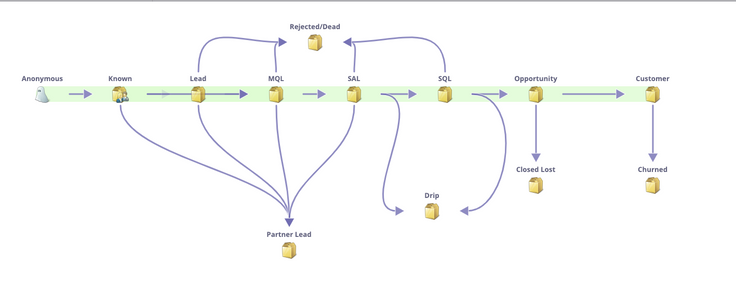Re: Leads skipping revenue stages in Revenue Modeler
- Subscribe to RSS Feed
- Mark Topic as New
- Mark Topic as Read
- Float this Topic for Current User
- Bookmark
- Subscribe
- Printer Friendly Page
- Mark as New
- Bookmark
- Subscribe
- Mute
- Subscribe to RSS Feed
- Permalink
- Report Inappropriate Content
Hi All,
Lifecycle Modeler newbie here. We've had a lifecycle program in place for quite sometime, but not the revenue modeler within Marketo, so I am starting to build the revenue modeler to match my lifecycle program to get the lead velocity metrics, avg time in each stage, etc..
This is what I have so far (below)
My main question is how does the revenue modeler handle people that are fast tracked through stages (essentially skipping some stages and progressing to those past the "next stage" in the success path)
Meaning if a person goes from "Known" to "MQL" (let' say they fill out a demo request form) do I need to build a transition that goes from "Known" to "MQL"? (I've built one in the draft above) Also, from a reporting standpoint, what implications do these "fast tracked" people pose?
Meaning if a person jumps from "Known" to "MQL" will it skew the velocity metrics and avg time in each stage since technically the person was never in the "Lead" stage and actually just jumped over it to the "MQL" stage?
- Mark as New
- Bookmark
- Subscribe
- Mute
- Subscribe to RSS Feed
- Permalink
- Report Inappropriate Content
I tend to manage transitions with an Operational program, using smart campaigns to define each possible set of transitions. That way you can define rules for "any previous stage" to MQL as a single smart campaign. Using the operational program also ensures your different flows and rules are a little easier to see and manage.
- Mark as New
- Bookmark
- Subscribe
- Mute
- Subscribe to RSS Feed
- Permalink
- Report Inappropriate Content
Hey Katja,
Thanks for your response, that's what I plan on doing as well. So it sounds like I will still need a transition from "Lead to MQL" as well as "Known to MQL" and just list the transition criteria as "Manual stage change"? Additionally, there shouldn't be an issue with a fast tracked lead skipping the "Lead" stage?
- Mark as New
- Bookmark
- Subscribe
- Mute
- Subscribe to RSS Feed
- Permalink
- Report Inappropriate Content
When you use smart campaigns like that, technically you do not need an arrow in your model for every permutation. So for skips on the success path I think you can do without the extra clutter in your diagram. That being said, I would try to visualize possible detours as accurately as possible without going spaghetti-diagram.
- Copyright © 2025 Adobe. All rights reserved.
- Privacy
- Community Guidelines
- Terms of use
- Do not sell my personal information
Adchoices
